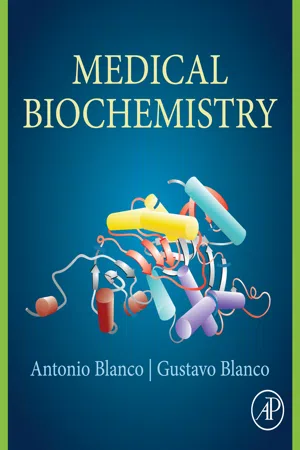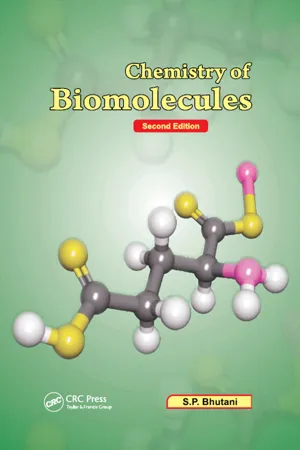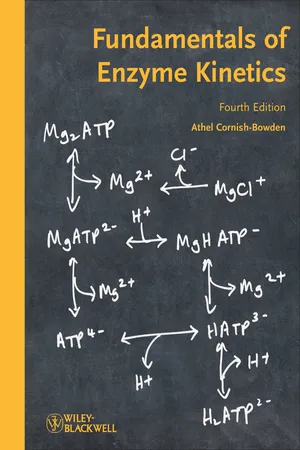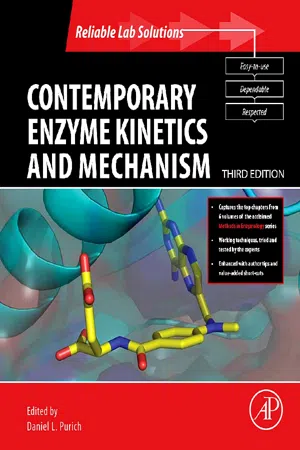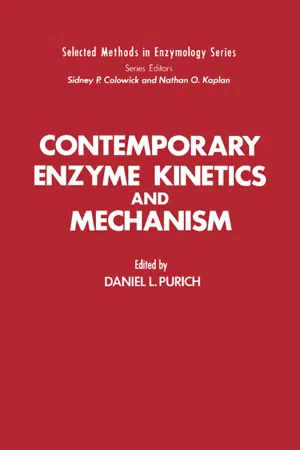Biological Sciences
Factors Affecting Enzyme Activity
Factors affecting enzyme activity include temperature, pH, substrate concentration, and the presence of inhibitors or activators. Enzymes function optimally within specific temperature and pH ranges, and their activity is influenced by the concentration of substrate molecules. Inhibitors can decrease enzyme activity, while activators can enhance it. These factors collectively impact the efficiency of enzyme-catalyzed reactions.
Written by Perlego with AI-assistance
Related key terms
Related key terms
1 of 4
Related key terms
1 of 3
10 Key excerpts on "Factors Affecting Enzyme Activity"
- eBook - ePub
- Azhar ul Haque Sario, Azhar ul Haque Sario(Authors)
- 2023(Publication Date)
- tredition(Publisher)
Monitoring reactant and product concentrations to trace the course of enzyme-catalyzed reactions is a cornerstone technique in biochemistry. It offers invaluable insights into enzyme efficiency and regulation, impacting a wide array of scientific and medical applications. This understanding paves the way for progress in areas like drug development, disease diagnosis, and biotechnological innovation. As scientific research advances, emerging methodologies and technologies continually refine our capability to examine these essential biological catalysts, deepening our grasp of the molecular foundations of life.The investigation into how temperature and pH affect enzyme activity is a crucial aspect of biochemistry, with significant implications in various biological processes and practical applications. This comprehensive exploration aims to provide a detailed understanding of these influences.Introduction to Enzymes and Their Importance Enzymes are biologically active proteins that play a pivotal role in facilitating and accelerating biochemical reactions within living organisms. These catalysts are essential for numerous physiological processes, including digestion, metabolism, DNA replication, and many others. Their ability to lower the activation energy of reactions is central to their functionality.Impact of Temperature on Enzyme Activity Fundamental Concepts: Temperature influences enzyme activity profoundly. Enzymes, being proteins, have a specific three-dimensional structure crucial for their function. The rate of biochemical reactions generally increases with temperature due to enhanced kinetic energy, leading to more frequent collisions between enzyme and substrate.Optimal Temperature: Each enzyme has an optimal temperature range where its activity is maximized. This is typically around the normal body temperature for enzymes in humans (approximately 37°C). Within this range, enzymes exhibit maximum efficiency.Low Temperatures: At low temperatures, the kinetic energy of molecules decreases, leading to reduced collisions between enzymes and substrates. This results in a diminished rate of reaction. - eBook - ePub
Medicinal Chemistry
An Introduction
- Gareth Thomas(Author)
- 2011(Publication Date)
- Wiley(Publisher)
The mechanisms of the reactions at the active sites of enzymes have been widely investigated. There is now no doubt that the increased speed of enzyme-catalysed reactions is due in part to the close proximity and the correct alignment of the reactants at the active site. A detailed knowledge, obtained from X-ray crystallography, of the three-dimensional structures of the enzyme and bound substrate plus other experimental evidence means that in many cases the details of enzyme action have been established. This has resulted in the proposal of reaction mechanisms for a number of processes. However, it should be realised that each mechanism is specific for the enzyme-substrate system under consideration.9.7 The general physical factors affecting enzyme actionThe main physical factors affecting enzyme action are the relative concentrations of the enzyme and substrate, the pH and the temperature. If the concentration of the substrate is kept constant, the rate of the reaction increases with an increase in enzyme concentration. However, if the concentration of the enzyme is kept constant, as is likely in biological processes, and the concentration of the substrate is increased, the rate of reaction increases to a maximum value known as the saturation value (Fig. 9.11a ). This maximum rate corresponds to the saturation of all the available active sites of the enzyme. In the case of enzymes that are under feedback control (see section 9.4.2) the curve is sigmoidal (Fig. 9.11b ), as against hyperbolic for enzymes not under feedback control but still regulated by a modulator, that is, under allosteric control.Figure 9.11The effect of concentration on the rate of allosteric (a) modulated and (b) feedback-regulated enzyme-catalysed reactionsEnzymes are only usually effective over specific ranges of pH characteristic of the enzyme (Fig. 9.12 ). These ranges usually correspond to the pH of the environment in which the enzyme occurs. Outside this range the enzyme may undergo irreversible denaturationFigure 9.12The effect of pH and temperature on the rates of enzyme-catalysed reactionswith subsequent loss of activity. Initially an increase in temperature will usually result in an increase in the rate of an enzyme-controlled reaction. However, enzymes are sensitive to temperature and once it increases beyond a certain point the protein irreversibly denatures and the enzyme becomes inactive. An enzyme’s operating temperature range will normally correspond to about that of its normal environment. - eBook - ePub
Biomolecules
From Genes to Proteins
- Shikha Kaushik, Anju Singh(Authors)
- 2023(Publication Date)
- De Gruyter(Publisher)
Figure 3.5: Peptide hydrolysis by chymotrypsin.3.4 Factors Affecting Enzyme Activity
The activity of an enzyme is affected by its environmental conditions. Any change in the solution conditions alters the rate of reaction and hence the progress of an enzyme-catalyzed reaction. In nature, organisms adjust the conditions of their enzymes to produce an optimum rate of reaction, where necessary, or they may have enzymes that are adapted to function well in extreme conditions where they live. There are several factors which affect the rate at which enzymatic reactions proceed such as pH, temperature, ionic strength, enzyme concentration, substrate concentration, and the presence of any activators or inhibitors.3.4.1 pH – Acidity and Basicity
pH refers to the hydrogen ion (H+ ) concentration in solution, and it measures the acidity and basicity of a solution. The pH scale ranges from 0 to 14; however, negative pH values and values above 14 are also possible. Lower pH values mean higher H+ concentrations and lower OH– (hydroxide ion) concentrations.The activity of an enzyme is its ability to function, and it can be defined as the micromoles of product formed per minute under standard conditions:1 u n i tU= 1μ m o l / m i nThe activity of an enzyme varies with the pH of the solution. As the pH of the solution is lowered, an enzyme will gain a proton (H+ ); similarly the enzyme will lose a proton on raising the pH of the solution. Under both conditions, the ionization state of acidic and basic amino acids will be changed, which can interfere with the hydrogen bonding and ionic interactions that help in maintaining the tertiary structure of protein molecules. This interference causes a change in shape of the enzyme, and most importantly disrupts its active site. Any change in the shape or polarity of the active site would minimize the interaction between the substrate and enzyme, and hence affects the rate of biochemical reaction. Each enzyme has an optimum pH – pH at which the activity of an enzyme is maximum, and at this pH, the shape of the active site is best suited to the shape of the substrate. Any change in pH above or below the optimum pH will quickly cause a decrease in the rate of reaction as enzyme molecules will have active sites whose shapes are not, or less, complementary to the shape of their substrate. The effect of pH on the rate of an enzyme-catalyzed reaction is displayed in Figure 3.6 - eBook - ePub
- Antonio Blanco, Gustavo Blanco(Authors)
- 2017(Publication Date)
- Academic Press(Publisher)
m value is usually considered the natural or “physiological” substrate for that enzyme.Temperature . The rate of a chemical reaction increases, when temperature rises, as a result of the increase in kinetic energy in the system. Within certain limits, enzyme-catalyzed reactions follow this behavior and the speed of many biological reactions almost doubles for every 10°C increase in temperature. This activity–temperature increase in the reaction rate is called Q 10 or temperature coefficient . If concentrations of enzyme, substrate, and other factors of the reaction medium are maintained constant and the reaction activity is determined at increasing temperatures, the curve shown in Fig. 8.7 is obtained.Figure 8.7 Effect of temperature on enzyme activity. Enzyme activity is expressed as percent of the maximal activity achieved. Experimental points are not shown.Although enzyme activity increases with temperature, a maximum value is reached, which corresponds to the optimal temperature for the catalytic activity of a given enzyme. Above this temperature, enzyme activity rapidly drops.For the great majority of warm-blooded animal enzymes, the optimal temperature is approximately 37°C. Beyond that temperature, activity decreases, and approaching 60°C, most of the enzymes are completely inactivated. This inactivating effect of temperature, which occurs above 40°C, is explained by the denaturing action that heat has on the molecular structure of the enzyme.pH . If enzyme activity is measured at different pH values, maintaining other conditions constant, the effect of the hydrogen ion concentration becomes apparent (Fig. 8.8 ).Figure 8.8 Effect of pH on enzyme activity. Enzyme activity is expressed as a percent of the maximum activity achieved. Experimental points are not shown.For most enzymes, optimum activity is between pH 6 and 8. Below or above these values, the reaction rate drops more or less rapidly. However, exceptions include gastric pepsin which exhibits maximal activity at acidic pH (around 1.5). Acid phosphatase, abundant in the male prostate, exhibits its greatest activity at pH 5 and alkaline phosphatase from bone and other organs has optimal activity at a pH of 9.5. - No longer available |Learn more
MCAT Biochemistry Review 2024-2025
Online + Book
- (Author)
- 2023(Publication Date)
- Kaplan Test Prep(Publisher)
y-intercepts in a Lineweaver–Burk plot represent?- x-intercept: ________________________________________
- y-intercept: ________________________________________
- What is enzyme cooperativity? ________________________________________
2.4 Effects of Local Conditions on Enzyme ActivityLEARNING OBJECTIVES
After Chapter 2.4, you will be able to:- Predict how changes to the environment will alter enzyme behavior
- Estimate the ideal pH and temperature for enzymes found in the human body
The activity of an enzyme is heavily influenced by its environment; in particular, temperature, acidity or alkalinity (pH), and high salinity have significant effects on the ability of an enzyme to carry out its function. Note that the terms enzyme activity, enzyme velocity, and enzyme rate are all used synonymously on the MCAT.Temperature
Enzyme-catalyzed reactions tend to double in velocity for every 10°C increase in temperature until the optimum temperature is reached; for the human body, this is 37°C (98.6°F or 310 K). After this, activity falls off sharply, as the enzyme will denature at higher temperatures, as shown in Figure 2.7 . Some enzymes that are overheated may regain their function if cooled. A real-life example of temperature dependence occurs in Siamese cats. Siamese cats are dark on their faces, ears, tails, and feet but white elsewhere. Why? The enzyme responsible for pigmentation, tyrosinase, is mutated in Siamese cats. It is ineffective at body temperature but at cooler temperatures becomes active. Thus, only the tail, feet, ears, and face (cooled by air passing through the nose and mouth) have an active form of the enzyme and are dark.Figure 2.7 Effects of Temperature and pH on the Rate of Enzyme ActionpH
Most enzymes also depend on pH in order to function properly, not only because pH affects the ionization of the active site, but also because changes in pH can lead to denaturation of the enzyme. For enzymes that circulate and function in human blood, this optimal pH is 7.4, as shown in Figure 2.7 . A pH < 7.35 in human blood is termed acidemia. Even though it’s more basic than chemically neutral 7.0, it is more acidic than physiologically - eBook - ePub
- S. P. Bhutani(Author)
- 2019(Publication Date)
- CRC Press(Publisher)
e.g., enzymes of various species of bacteria inhabiting hot springs are active at temperatures exceeding 85°C. Some enzymes, such as ribonuclease lose activity on heating but quickly regain it on cooling indicating that their unfolded polypeptide chain quickly reverts back into its natural conformation.B. Effect of pH on Enzyme Activity
The symbol pH refers to the concentration of hydrogen ions in solution. The activity of an enzyme varies with the pH of the medium. Most enzymes have a characteristic pH at which their activity is maximum. Above or below this pH the activity declines. When we plot activity versus pH most enzymes yield a bell-shaped curve with a more or less sharply defined maximum. That means enzymes have maximum activity at optimum pH. Figure 3.2 illustrates the relationship between the pH and activity of the enzyme invertase.We give below in Table 3.2 , the optimum pH for some typical enzymes. The optimum pH of an enzyme is not ncessarily identical with the pH of its normal intracellular surroundings.Even small changes in pH can have a great effect on enzyme activity. Small changes in pH mean relatively large changes in [H+ ]. A change of 1 on the pH scale involves a ten-fold increase or decrease in [H+ ], while a change in pH of 2 represents a hundred-fold change in [H+ ]. The concentration of [H+ ] affects the stability of the electrovalent bonds which help to maintain the tertiary structure of protein molecules. Extremes of pH cause the bonds to break resulting in enzyme denaturation.Fig. 3.2 Relationship between the pH and activity of the enzyme.The affinity of an enzyme for its substrate may be altered by variations in pH. Changes in [H+ ] can alter the ionisation of the amino acid side chains at the active centres of enzymes. Ionisation of the substrate molecules can also be affected. The formation of enzyme-substrate complexes depends on the active centres and substrate molecules having opposite electrostatic charges. If the charges are altered by changes in pH, some enzymes fail to function.TABLE 3.2. Optimum pH for Some Enzymes - eBook - ePub
- Athel Cornish-Bowden(Author)
- 2013(Publication Date)
- Wiley-Blackwell(Publisher)
Chapter 10 Effect of pH on Enzyme Activity10.1 Enzymes and pH
Of the many problems that beset the first investigators of enzyme kinetics, none was more important than the lack of understanding of hydrogen-ion concentration, [H+ ]. In aqueous chemistry, [H+ ] varies from about 1 M to about 10−14 M, an enormous range that is commonly decreased to more manageable proportions by the use of a logarithmic scale, pH = − log [H+ ]. All enzymes are profoundly influenced by pH, and no substantial progress could be made in the understanding of enzymes until Michaelis and his collaborators made pH control a routine part of all serious enzyme studies. The concept of buffers for controlling the hydrogen-ion concentration, and the pH scale for expressing it, were first published by Sørensen, in a classic paper1 on the importance of hydrogen-ion concentration in enzyme studies. Michaelis, however, was already working on similar lines, and it was not long afterwards that the first of his many papers on effects of pH on enzymes appeared, written with Davidsohn. Although there are still some disagreements about the proper interpretation of pH effects in enzyme kinetics, the practical importance of pH continues undiminished: it is hopeless to attempt any kinetic studies without adequate control of pH.SØREN PETER LAURITZ SØRENSEN (1868–1939) was born near Slagelse (Denmark), and studied first medicine and then chemistry in Copenhagen. He made his career at the Carlsberg Laboratories, where he was particularly interested in amino acids and proteins. The effect of temperature on enzyme activity was already reasonably well understood, but Sørensen realized that this was far from being the only factor, and that there was an urgent need for developing methods for measuring and controlling the concentration of hydrogen ions.It may seem surprising that it was left to enzymologists to draw attention to the importance of hydrogen-ion concentration and to introduce the use of buffers. We may reflect, therefore, on the special properties of enzymes that made pH control imperative before any need for it had been felt in the already highly developed science of chemical kinetics. With a few exceptions, such as pepsin and alkaline phosphatase, the enzymes that have been most studied are active only in aqueous solution at pH values in the range 5–9. Indeed, only pepsin has a physiologically important activity outside this middle range of pH. Now, in the pH range 5–9, the hydrogen-ion and hydroxide-ion concentrations are both in the range 10−5 –10−9 - eBook - ePub
A Study of Enzymes
Enzyme Catalysts, Kinetics, and Substrate Binding
- Stephen A. Kuby(Author)
- 2019(Publication Date)
- CRC Press(Publisher)
Chapter 4EFFECTS OF pH AND TEMPERATURE
I. EFFECT OF pH ON THE REACTION VELOCITY
A. Introduction
Recently, the pH dependence of an enzyme-catalyzed reaction has become a popular approach to identifying substrate or activator moieties and enzymic active-site ionizable residues which play a role in substrate binding and in catalysis (see References 775 to 777 ). When properly applied, pH studies may yield a great deal of information concerning the mechanism of the enzyme-catalyzed reaction.As will be seen below, the basic technique is simple and involves measuring the variation in the maximum velocity (Vmax ) and the ratio of Vmax /Ks (which is an apparent second-order rate constant in units, e.g., of M −1 s−1 , if Vmax is expressed in units of reciprocal seconds which appears to be the current usage) for the reaction of the substrate, and/or the Ki for the binding of an inhibitor or activator, as a function of the reaction pH. The kinetic parameter which is being measured, as we will see, will then begin to change as the reaction pH increases above or decreases below the pKa , depending on whether the group must be protonated or deprontonated for proper function. The pH profile of the reaction is then simply constructed by plotting the log of the kinetic parameter vs. the pH of the reaction. The number of ionizing groups, as we will see, will be defined by the slope of the curve, while the apparent pKa of the ionizing group(s) will be defined by the intersection of the asymptotes to the curve. It is common today to determine by computer fitting both the number of ionizing groups and their apparent pKa values, i.e., by computer fitting the data to the rate equation which appropriately describes the type of ionization involved. It may be noted at this point that the pH profiles of functions which represent equilibrium binding (i.e., Ki for substrates or competitive inhibitors and Ki and Km for metal cofactors) will yield true pKa values. In the case of Vmax or Vmax - eBook - ePub
Contemporary Enzyme Kinetics and Mechanism
Reliable Lab Solutions
- (Author)
- 2009(Publication Date)
- Academic Press(Publisher)
Chapter 6 Effects of pH on Enzymes*Keith F. Tipton, Andrew G. McDonald Henry B.F. Dixon✠ , Department of Biochemistry, Trinity College, Dublin 2, Ireland- Abstract
- I. Theory
- A. The Ionization of Dibasic Acids (Adams, 1916 )
- B. Simplified System
- C. Methods of Obtaining Ionization Constants
- D. Complications
- E. Interpretation of the Results of pH Experiments
- F. pH-Independence of K m
- G. Identification of Amino Acid Residues from Their Ionizations
- II. Limitations of the Methods
- III. Practical Aspects
- A. Effects of pH on the Stability of Enzymes
- B. Effects of pH on Substrates
- C. Effects of pH on the Assay Method
- D. Buffers
- IV. Some Examples of pH Studies
- A. Carnitine Acetyltransferase
- B. Fumarate Hydratase
- C. Lysozyme
- V. Future Prospects
- References
The effects of variations of the hydrogen ion concentration on the activity of enzymes have close similarities to the effects of activators and inhibitors, and the same kinetic methods and theory can be applied to both types of system. These close similarities are often obscured, however, by the fact that a logarithmic scale (pH) is usually used for hydrogen ion concentration. Treatment of the effects of hydrogen ion concentration in the same way as other effectors can yield valuable information on the nature of the kinetic mechanism obeyed by the enzyme; in addition, the characteristic ionization constants of amino acid side-chain groups has led to the use of such studies in attempts to identify specific groups as playing a role in the reaction. This latter approach has frequently been regarded as being the most important function of these studies. These two aspects of the subject, however, are complementary, and attempts to identify groups from pH studies without considering the kinetic aspects not only will miss a great deal of valuable information, but also can frequently lead to erroneous conclusions. In this chapter, we will consider the effects of hydrogen ion concentration on the activity of enzymes both in terms of kinetic analysis with the hydrogen ion concentration as the variable and in terms of the use of the effects of pH to identify specific ionizing groups. - eBook - ePub
Contemporary Enzyme Kinetics and Mechanism
Selected Methods in Enzymology
- Daniel L. Purich(Author)
- 1983(Publication Date)
- Academic Press(Publisher)
Chapter 13 of the book by Laidler and Bunting,17 where references to other articles and reviews are given.It is necessary to consider both temperature and pH effects on enzyme inactivations, since the two effects are closely related. It is usually found that rates of inactivation pass through a minimum as the pH is varied, and the behavior is frequently quite complex. A satisfactory treatment of pH and temperature effects has been given by Levy and Benaglia25 on the basis of the various ionized states, P1 , P2 , P3 , etc., in which a protein can occur. Suppose that P1 is the form in which the protein exists in the most acid solutions, and that P2 is P1 which has lost a proton, etc:k =(/)k Dkc h e m()k D+kc h e mEach form can go into a denatured form D with a rate constant k 1 , k 2 , etc. If one of the intermediate rate constants, such as k 3 , is smaller than the others, the overall rate of denaturation will pass through a minimum at the pH at which the corresponding form (e.g., P3 ) is predominant.A satisfactory treatment of temperature effects obviously requires that the rate constants k 1 , k 2 , etc. and the dissociation constants K 1 , K 2 , etc. are separated, on the basis of a pH study, and that their values are determined over a range of temperatures. This has been done in only a few cases, the most complete study being for the denaturation of ricin.25 On the basis of the above scheme, the form P4
Index pages curate the most relevant extracts from our library of academic textbooks. They’ve been created using an in-house natural language model (NLM), each adding context and meaning to key research topics.
Explore more topic indexes
Explore more topic indexes
1 of 6
Explore more topic indexes
1 of 4



